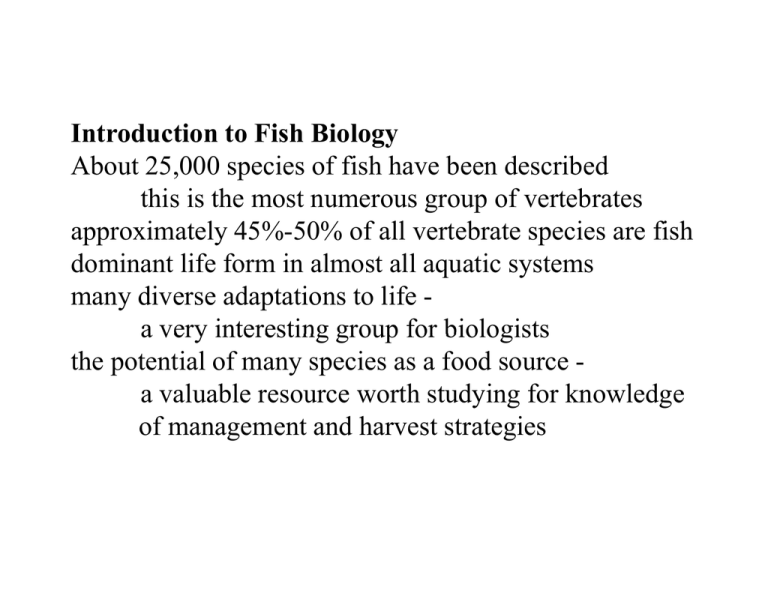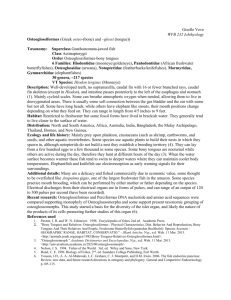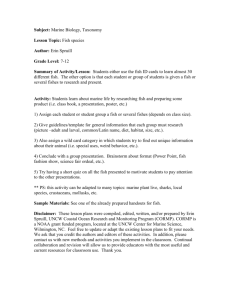Introduction to Fish Biology
advertisement

Introduction to Fish Biology About 25,000 species of fish have been described this is the most numerous group of vertebrates approximately 45%-50% of all vertebrate species are fish d i t life dominant lif form f in i almost l t all ll aquatic ti systems t many diverse adaptations to life a very interesting group for biologists the potential of many species as a food source a valuable resource worth studying for knowledge of management and harvest strategies Common characteristic of fishes cranium backbone, live in water, possess gills throughout life, theyy either have or are descended from ancestors that had scales or armor derived from dermal tissue Fish Phylogeny several diverse evolutionary lines are lumped together and commonly called fishes Fish Classification Phylum y Chordata have notochord at some time in their lives, have a post-anal tail at some time, dorsal tubular nerve cord, have gill slits, pharyngeal basket, basket Subphylum Vertebrata (or Craniata) all groups have vertebrae surrounding nerve cord, cranium S Superclass l Myxinomorphi M i hi Class Myxini – hagfishes p Petromyzontomorphi y p Superclass Class Cephalaspidomorphi – lampreys and extinct relatives lampreys and hagfishes formerly lumped into Class Agnatha based on superficial similarities: no jaws, skel. of cartilage, persistent notochord All groups from this point on have jaws and paired appendages Superclass Gnathostomata – jawed vertebrates Class Chondrichthyes - cartilaginous fishes sharks, skates, rays, j jaws, paired i d appendages, d skeleton k l t off cartilage, til All groups from this point on have a skeleton with bone Grade Teleostomi (formerly “Osteichthyes”) Class Sarcopterygii – lobe-finned fishes and tetrapods fish in this class include coelacanths, lungfishes, and extinct relatives tetrapods include amphibians, reptiles, birds, and mammals Class Actinopterygii Actinopter gii – ray-finned ra finned fishes – all other fishes Classes Myxini, Cephalaspidomorphi, Chondrichthyes, Sarcopterygians (excluding tetrapods) and Actinopterygians are collectively called fishes all fish are vertebrates with gills throughout life and live almost exclusively l i l in i water t andd lack l k four f legs l Statistics on fishes Numbers of species hagfish - 70 spp – all marine scavengers and predators lampreys - 38 spp – freshwater and marine, pparasitic s c andd filter e feeders eede s within the Chondrichthyes sharks - 403 spp - mostly large marine pred, a few in freshwater rays and skates - 534 spp. spp - mostly marine, marine 30 in freshwater chimaeras - 33 sp – all marine, most in deep water Teleostomes (“Osteichthyes”) – about 24,000 spp and 40% of all vertebrates within this group Sarcopterygians p yg - lobefins - fleshyy bases on ppaired fins lungfishes - 6 spp – all in freshwater, one in Australia, one in South America, and four in Africa coelacanth - 2 spp - Latimeria - only in Indian Ocean once thought extinct - 1938 fisherman captured one Actinopterygians - ray finned fishes – Cl di i Cladistians – bichirs bi hi (16) – all ll freshwater f h Chondrosteans - sturgeons (25), paddlefish (2) mostly freshwater Neopterygians p yg Amiiformes - bowfin (1) freshwater Semionotiformes - gars (7) mostly freshwater Teleosteans - most species every aquatic habitat lakes, streams, desert springs, caves, seas from pole to pole, d deep seas both b th off ff andd on the th bottom, b tt within this group there is gradation in body forms from primitive to advanced (soft-rayed, spiny rayed) most of our familiar species here tarpon, eels, shad, salmon, piranhas, minnows, suckers, cod topminnows cod, topminnows, silversides, silversides sea horses, horses mullets, mullets perch, bass, gobies, remoras, scorpionfish, sculpins, flounders, puffers, boxfish, etc. The major lineages of fishes are very old The agnathans have a history that goes back 500 my by 400 mya all the major lineages were present So modern groups that are called fishes, at the class level aree very ve y distantly ds y related e ed andd separated sep ed by approximately pp o ey 400 my of evolution Within all this diversity 58% are marine i 41% are freshwater 1% euryhaline y within euryhaline species anadromous - move upstream to spawn - mostly in temperate zones catadromous - move downstream to spawn – mostly in tropics Questions Why is there so much diversity in freshwater? Why do species move into alternate habitats to spawn? Why are there anadromous forms in the temperate zones and catadromous forms in the tropics? Most marine species are coastal only 13% of all fish species live exclusively in open ocean 44% li live in i less l than th 200m 200 off water, t near the th coastt In both freshwater and marine fish groups, most species are found in the tropics In spite of diversity - we don't don t have any trouble recognizing most things that are fish - One thing that all fishes have in common is that they live in water and living in water imposes some constraints on them that they must live within - the properties of water limit the number of morphological, physiological, and ecological options for fishes Water is dense - 800 x air benefits - 1. buoyancy - little or no effect of gravity 2. allows more force to be exerted on it costs - resists movement most fish are streamlined - those that must move quickly, or over long distances most fish have a large proportion of the body as muscle for locomotion - Water is almost incompressible moving through air involves compression and displacement moving through water - all displacement this produces turbulence and drag benefits 1. displacements are detectable gives long-distance sense of touch allows fish to detect other fish and prey 2. allows for suction feeding and forceful ventilation water can be sucked into, and pumped out of mouth Slight compressibility of water sounds move further and faster - 4x faster than air fish don don'tt have external ears, ears but nearly all fish can hear a fish body is nearly the same density as water sound waves pass readily through fish bodies use internal structures (otoliths) of different density and swim bladders to intercept sound waves all hear and manyy can make sounds and use them for communication Water is a good solvent dissolved solutes necessary for aquatic life as nutrients creates a problem fish must resist being dissolved themselves - having their solutes l t lost l t by b diffusion, diff i or in i conditions diti off high hi h salinity li it losing their water through osmosis - later one additional factor makes this problem a special problem oxygen is not very soluble in water air is 21% O2 water is 0.8% O2 (8ml/l, or 12.8 mg/l) max. solubility decreases with increases in temperature and salinity can limit fish activities, to compensate, compensate fish have ha e a large portion of the surface s rface area of their bodies very permeable - the gills for extracting oxygen, but also provides an easy entry and exit point for solutes and water Water has W h low l light li h penetration i 1000 m max (pure water) most fish in lighted g zone (p (productive zone)) most fish live in a relatively murky and dark environment compensate through highly developed sense of touch, smell some have electric organs (fields that can be used smell, to detect movements) or electric sense to detect the weak electric charge of other living things, some make k their h i own light li h The biology gy of fishes is the biology gy of active livingg organisms g in water. The properties of water limit and shape the biology of fishes.






